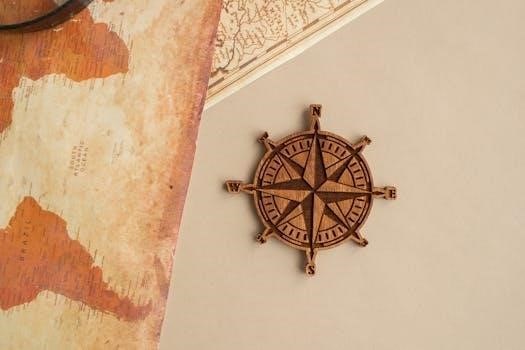
Knife sharpening angle guides are essential tools for maintaining the correct bevel on your blades. These guides assist users in achieving consistent and precise sharpening, regardless of experience, ensuring optimal cutting performance and longevity for all knives.
What is a Knife Sharpening Angle Guide?
A knife sharpening angle guide is a tool designed to help users maintain a consistent angle between the knife blade and the sharpening surface. These guides ensure that each stroke during sharpening is done at the correct angle, preventing the edge from becoming too steep or too shallow. Angle guides come in various forms, including manual tools and built-in features on electric sharpeners, all aimed at improving sharpening precision and consistency for knives of all types.

Importance of Sharpening Angles
Maintaining the correct sharpening angle is crucial for a knife’s performance. It directly impacts the sharpness, durability, and overall cutting efficiency, ensuring each use is as effective as intended.
Why is Maintaining a Consistent Angle Crucial?
Maintaining a consistent sharpening angle is paramount because it ensures the knife’s edge remains sharp and effective. Inconsistent angles can lead to a dull edge, uneven wear, and increased effort while cutting. A consistent angle not only enhances cutting performance but also extends the life of the knife by preventing unnecessary damage and ensuring the blade performs at its peak. This precision is key for both safety and efficiency in any cutting task.

Understanding Knife Sharpening Angles
Knife sharpening angles are critical for blade performance. The angle determines the sharpness, durability, and cutting efficiency of a knife. Understanding these angles is essential for proper maintenance.
How Sharpening Angles are Measured
Sharpening angles are measured in degrees, representing the angle between the blade’s edge and the sharpening surface. These angles are typically measured on each side of the blade. Tools like angle cubes or calipers are used to precisely measure these angles. Alternatively, you can measure the knife with a caliper and then use an angle calculator to find the angle of the edge. Understanding how to measure these angles ensures you can consistently sharpen knives at their intended bevel.
The Relationship Between Edge Angle and Knife Type
The edge angle of a knife is directly related to its intended use and the type of blade. Finer, thinner blades, like Japanese knives, require shallower angles for precision cutting, while robust knives like cleavers need steeper angles for durability. The angle impacts how the knife performs; a smaller angle is for sharpness while a larger one is for toughness. Understanding the relationship between these two will help you select the best angle for each knife.

Types of Knife Sharpening Angle Guides
Various knife sharpening angle guides exist, including manual guides, electric sharpeners with guides, and adjustable guides. Each type caters to different user needs and preferences, ensuring accurate and consistent sharpening.
Manual Angle Guides
Manual angle guides are simple, often handheld tools designed to help maintain a consistent sharpening angle. They usually consist of slots or surfaces that the knife blade rests against, guiding the user’s hand to keep the correct angle during the sharpening process. These guides are a cost-effective and reliable option for users who prefer a hands-on approach to knife maintenance and sharpening, offering control and precision.
Electric Sharpeners with Angle Guides
Electric sharpeners with angle guides offer a convenient and automated approach to knife sharpening. These devices typically have built-in guides that hold the knife at the correct angle while the sharpening process is performed by powered abrasive wheels or belts. This method is faster and easier than manual sharpening, making it suitable for users who value efficiency. They often include multiple stages for different sharpening and honing steps.
Adjustable Sharpening Guides
Adjustable sharpening guides provide versatility by allowing users to set the desired sharpening angle, catering to a wide range of knife types. These guides often feature mechanisms to change the angle, making them suitable for various blades, including kitchen knives, hunting knives, and specialized tools. This adaptability ensures that each knife can be sharpened at its optimal angle for peak performance and longevity, accommodating different blade thicknesses and steel types.
Determining the Correct Sharpening Angle
Finding the correct sharpening angle is crucial for maintaining a knife’s original characteristics. Methods like using an angle cube or caliper help determine this angle accurately before sharpening.
Using an Angle Cube or Caliper
To accurately determine a knife’s sharpening angle, an angle cube or caliper can be employed. An angle cube directly measures the angle of the blade’s bevel, providing a precise reading. Alternatively, a caliper can measure the blade’s dimensions, which can then be used with an angle calculator to determine the angle. This ensures the maintenance of the original factory angle, preserving the knife’s intended cutting performance and characteristics. These methods offer accuracy for consistent sharpening.
The Scratch Test Method for Angle Identification
The scratch test is a method to find the correct sharpening angle by making light, controlled strokes on a sharpening stone and inspecting the resulting scratch pattern. This method does not directly measure the angle but reveals if the blade is meeting the stone at the correct angle. If the scratch mark appears evenly across the bevel, the angle is correct; if not, adjustments are needed. The goal is full, even contact for consistent sharpening, without damaging the blade, ensuring proper bevel maintenance.
Knife Sharpening Angle Chart
A knife sharpening angle chart provides recommended angles for various knife types. This chart helps users choose the correct angle to maintain sharpness and durability for different blades, enhancing their cutting experience.
Recommended Angles for Various Knife Types
The ideal sharpening angle varies depending on the knife’s purpose and design. Kitchen knives typically benefit from a 15-20 degree angle, offering a balance between sharpness and durability. Japanese knives, known for their precision, often use a 15-degree angle. Hunting and outdoor knives may require a more robust 20-25 degree angle for added strength. Understanding these variations is crucial for optimal knife performance, ensuring each blade is sharpened appropriately for its intended use.
Using a Sharpening Angle Guide
Using a sharpening angle guide ensures that the blade is held at a consistent angle during the sharpening process. This enhances the precision and effectiveness of edge restoration.
Step-by-Step Guide for Using Angle Guides
First, select the appropriate angle guide based on your knife type. Secure the blade within the guide, ensuring it’s held firmly. Position the knife and guide against the sharpening stone, maintaining consistent contact. Move the blade along the stone, following the guide’s angle. Repeat on both sides of the blade, ensuring even sharpening. Regularly check the edge, and continue until the desired sharpness is achieved. Clean the blade and the guide after use.
Maintaining a Consistent Angle
Maintaining a consistent sharpening angle is vital for edge longevity. Use guides, practice regularly, and focus on even strokes to achieve a sharp and durable knife edge.
Tips for Consistency During Sharpening
To achieve consistent results while sharpening, focus on maintaining a steady hand and using smooth, even strokes. Utilize a sharpening guide to help you maintain the correct angle throughout the process. Avoid applying excessive pressure; let the sharpening tool do the work. Practice regularly to develop muscle memory, which will contribute to more consistent and accurate sharpening over time. This ensures a uniformly sharp edge every time you sharpen.

Sharpening Angles for Different Knife Types
Different knives require specific sharpening angles. Kitchen knives often use 15-20 degrees, while Japanese knives may need 15 degrees. Hunting knives may have different angles based on their purpose and steel.
Angles for Kitchen Knives
For kitchen knives, a common sharpening angle range is between 15 to 20 degrees per side. This angle is suitable for general use, offering a balance between sharpness and edge durability. Chef’s knives and paring knives often fall within this range. Maintaining this angle ensures efficient cutting for everyday kitchen tasks, from slicing vegetables to preparing meats. However, specific kitchen knife types may have slight angle variations depending on their purpose and steel.
Angles for Japanese Knives
Japanese knives typically require a sharper angle than their Western counterparts, often around 15 degrees per side. This sharper angle is crucial for the delicate and precise cutting tasks these knives are designed for. This steeper bevel enhances cutting performance, particularly for intricate food preparation. However, it also means the blade may be more prone to chipping or damage if not handled carefully. Specific types of Japanese knives may have slight variations in their ideal sharpening angles.
Angles for Hunting and EDC Knives
Hunting and Every Day Carry (EDC) knives often benefit from a more robust edge angle, typically between 20 to 25 degrees per side. This wider angle provides greater durability for tougher tasks and materials. This increased angle helps prevent chipping and edge damage during heavy use. The selection of the exact angle can vary depending on the specific intended use and the material of the blade, as well as the user’s preferences and typical use patterns.
The Impact of Steel Type on Sharpening Angles
The type of steel significantly affects the ideal sharpening angle. Harder steels can hold a finer edge at a lower angle, while softer steels may require a wider angle for durability.
How Steel Affects the Ideal Angle
The composition and hardness of the steel used in a knife blade directly influence the ideal sharpening angle. Harder steels, like those found in some Japanese knives, can maintain a sharper edge at a lower angle, typically around 15 degrees. However, they might be more prone to chipping. Softer steels may require a slightly wider angle, such as 20 degrees, for enhanced durability and to prevent the edge from rolling over during use, balancing sharpness with resilience.
Advanced Sharpening Techniques
Advanced techniques like creating double-bevel edges enhance a knife’s performance. This involves using two distinct angles, a coarser one followed by a finer one for a durable and sharp edge.
Creating Double-Bevel Edges
Creating double-bevel edges involves using two different sharpening angles on a blade. Typically, a coarser angle is applied first to establish the primary bevel, followed by a slightly larger angle with finer grit. This technique enhances the edge’s durability and sharpness. The primary bevel provides strength, while the secondary bevel refines the edge for superior cutting performance. Double-bevel edges are often preferred for their balance between longevity and sharpness, making them ideal for various cutting tasks.
Knife sharpening angle guides are crucial for maintaining sharp and efficient blades. Understanding and using these guides ensures consistent sharpening results, prolonging the life and performance of your knives.